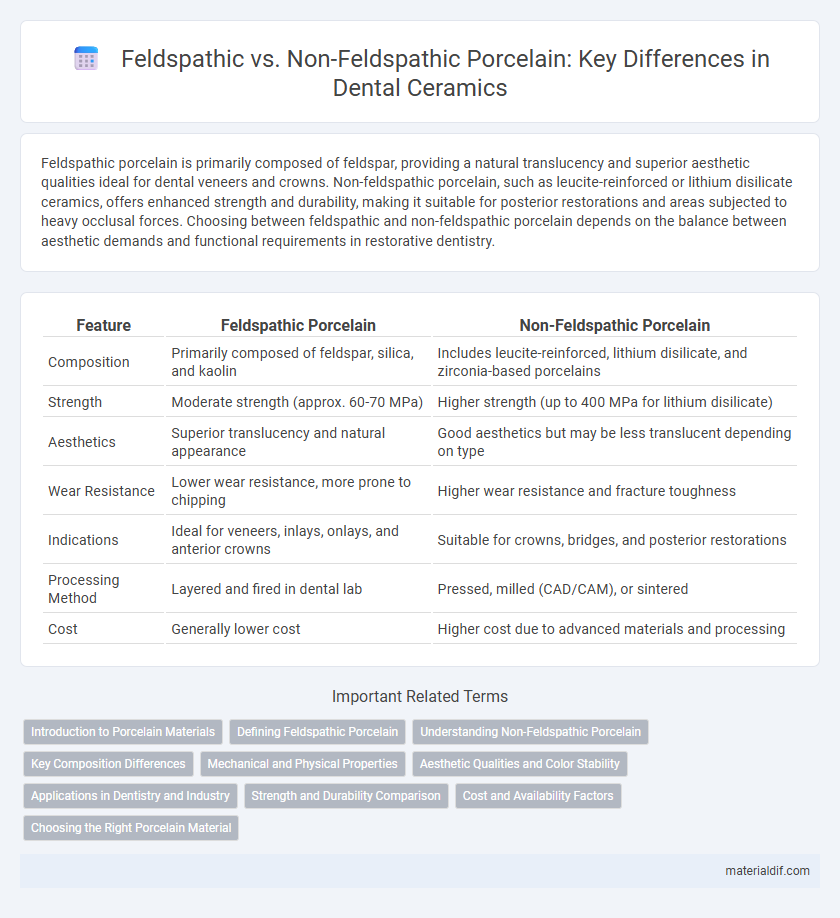Feldspathic porcelain is primarily composed of feldspar, providing a natural translucency and superior aesthetic qualities ideal for dental veneers and crowns. Non-feldspathic porcelain, such as leucite-reinforced or lithium disilicate ceramics, offers enhanced strength and durability, making it suitable for posterior restorations and areas subjected to heavy occlusal forces. Choosing between feldspathic and non-feldspathic porcelain depends on the balance between aesthetic demands and functional requirements in restorative dentistry.
Table of Comparison
| Feature | Feldspathic Porcelain | Non-Feldspathic Porcelain |
|---|---|---|
| Composition | Primarily composed of feldspar, silica, and kaolin | Includes leucite-reinforced, lithium disilicate, and zirconia-based porcelains |
| Strength | Moderate strength (approx. 60-70 MPa) | Higher strength (up to 400 MPa for lithium disilicate) |
| Aesthetics | Superior translucency and natural appearance | Good aesthetics but may be less translucent depending on type |
| Wear Resistance | Lower wear resistance, more prone to chipping | Higher wear resistance and fracture toughness |
| Indications | Ideal for veneers, inlays, onlays, and anterior crowns | Suitable for crowns, bridges, and posterior restorations |
| Processing Method | Layered and fired in dental lab | Pressed, milled (CAD/CAM), or sintered |
| Cost | Generally lower cost | Higher cost due to advanced materials and processing |
Introduction to Porcelain Materials
Feldspathic porcelain primarily consists of feldspar, quartz, and kaolin, offering superior esthetics and translucency ideal for dental veneers and crowns. Non-feldspathic porcelain is reinforced with materials like alumina or leucite, enhancing strength and fracture resistance for applications requiring durability. Understanding these fundamental differences is essential in selecting the appropriate porcelain material for dental restorations.
Defining Feldspathic Porcelain
Feldspathic porcelain is defined by its primary composition of feldspar minerals, which provide high translucency and esthetic qualities ideal for dental restorations. Compared to non-feldspathic porcelain, it offers superior mimicry of natural enamel due to its glassy matrix, enhancing light transmission and color matching. Its microstructure primarily comprises leucite crystals embedded in a glassy feldspathic matrix, contributing to its durability and aesthetic appeal.
Understanding Non-Feldspathic Porcelain
Non-feldspathic porcelain, unlike feldspathic porcelain, primarily contains materials such as alumina, zirconia, and leucite, which enhance its strength and fracture resistance. These porcelains are favored in dental restorations for their superior mechanical properties and reduced brittleness, making them suitable for load-bearing areas. Understanding non-feldspathic porcelain's composition and performance is crucial for selecting appropriate materials in restorative dentistry with longevity and durability in mind.
Key Composition Differences
Feldspathic porcelain primarily consists of feldspar, silica, and kaolin, providing a natural translucency and aesthetic appearance ideal for dental restorations. Non-feldspathic porcelain incorporates alternative materials such as alumina, leucite, or lithium disilicate to enhance strength and fracture resistance while sacrificing some translucency. These composition variations dictate the clinical applications, with feldspathic porcelain preferred for anterior aesthetics and non-feldspathic materials used in high-stress posterior restorations.
Mechanical and Physical Properties
Feldspathic porcelain exhibits superior translucency and aesthetic qualities due to its high glass content but has lower mechanical strength and fracture resistance compared to non-feldspathic porcelain. Non-feldspathic porcelains, such as leucite-reinforced and lithium disilicate ceramics, demonstrate enhanced flexural strength and toughness because of their crystalline phase reinforcement. The physical properties of non-feldspathic porcelain typically include higher hardness and improved wear resistance, making them more suitable for load-bearing dental applications.
Aesthetic Qualities and Color Stability
Feldspathic porcelain offers superior aesthetic qualities due to its high glass content, resulting in excellent translucency and natural enamel-like appearance. Non-feldspathic porcelain, such as zirconia or lithium disilicate, provides enhanced color stability and strength but often lacks the same level of translucency, making it less ideal for highly aesthetic anterior restorations. The balance between aesthetic appeal and long-term color stability is critical when choosing between feldspathic and non-feldspathic porcelains for dental restorations.
Applications in Dentistry and Industry
Feldspathic porcelain, valued for its excellent esthetics and translucency, is predominantly used in dental veneers, crowns, and inlays where lifelike appearance is crucial. Non-feldspathic porcelain, including leucite-reinforced and lithium disilicate types, offers superior strength and fracture resistance, making it suitable for load-bearing dental restorations and industrial applications such as electrical insulators and wear-resistant coatings. The choice between feldspathic and non-feldspathic porcelains depends on the balance required between aesthetic properties and mechanical durability in both dentistry and industrial contexts.
Strength and Durability Comparison
Feldspathic porcelain exhibits lower strength and durability compared to non-feldspathic porcelain due to its high glass content, making it more prone to chipping and fracture under stress. Non-feldspathic porcelain, such as lithium disilicate and zirconia-based ceramics, offers superior mechanical properties with enhanced fracture toughness and flexural strength, suitable for load-bearing dental restorations. The increased crystallinity in non-feldspathic materials significantly improves their resistance to wear and long-term degradation in oral environments.
Cost and Availability Factors
Feldspathic porcelain, derived primarily from natural feldspar minerals, generally incurs higher production costs due to its complex formulation and firing process, impacting its market price and availability. Non-feldspathic porcelain, often composed of alternative synthetic or mixed mineral components, tends to be more cost-effective and widely available because of less expensive raw materials and simplified manufacturing methods. These factors make feldspathic porcelain more common in high-end applications where aesthetics and translucency are prioritized, while non-feldspathic options prevail in budget-conscious or mass-produced contexts.
Choosing the Right Porcelain Material
Feldspathic porcelain, known for its excellent esthetics and translucency, is ideal for anterior restorations where natural appearance is crucial, while non-feldspathic porcelains such as lithium disilicate offer superior strength suited for posterior crowns and bridges. Selecting the right porcelain material depends on balancing esthetic demands and functional requirements, considering factors like fracture resistance, wear compatibility, and occlusal load. Dentists should evaluate patient-specific needs and restoration location to optimize longevity and performance of the chosen porcelain type.
Feldspathic porcelain vs Non-feldspathic porcelain Infographic

 materialdif.com
materialdif.com